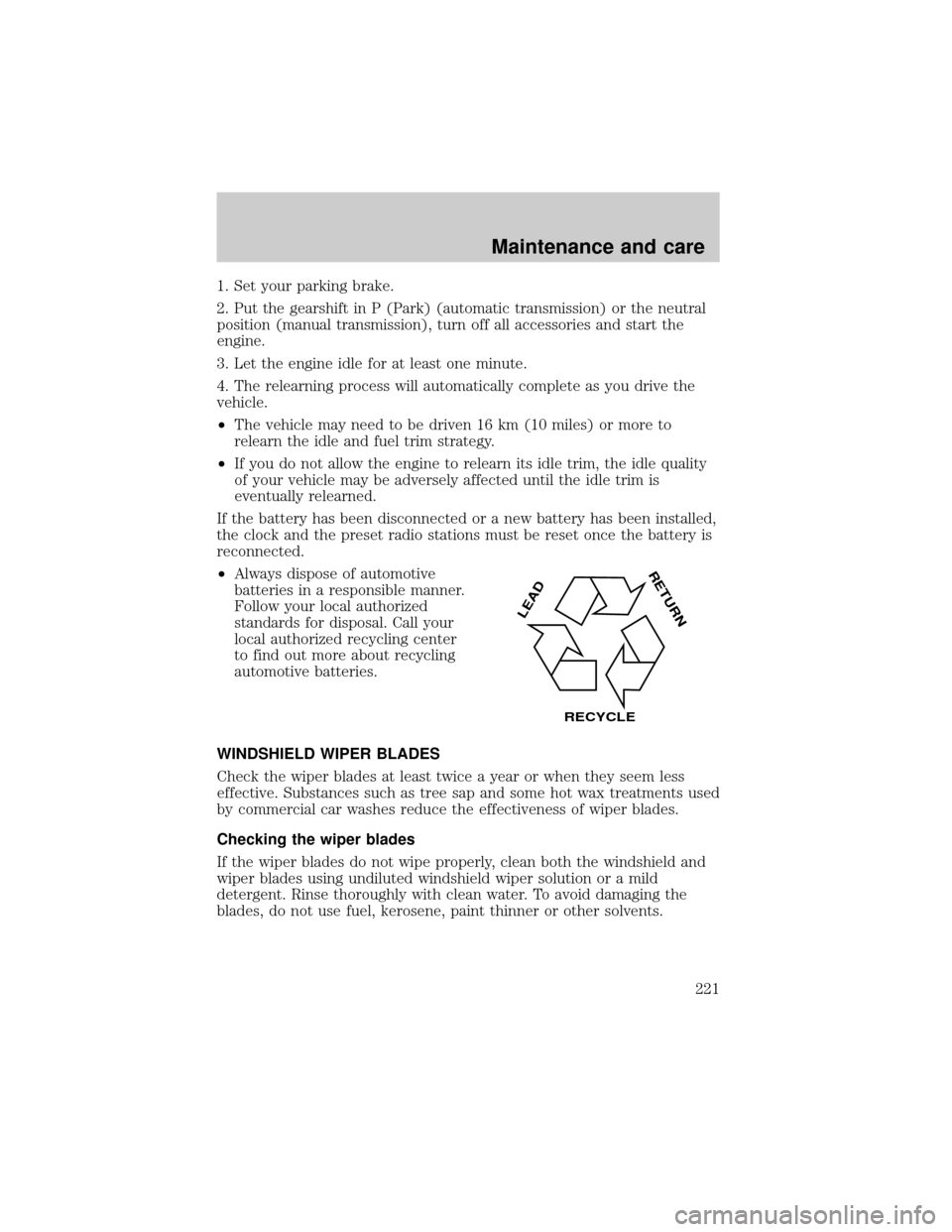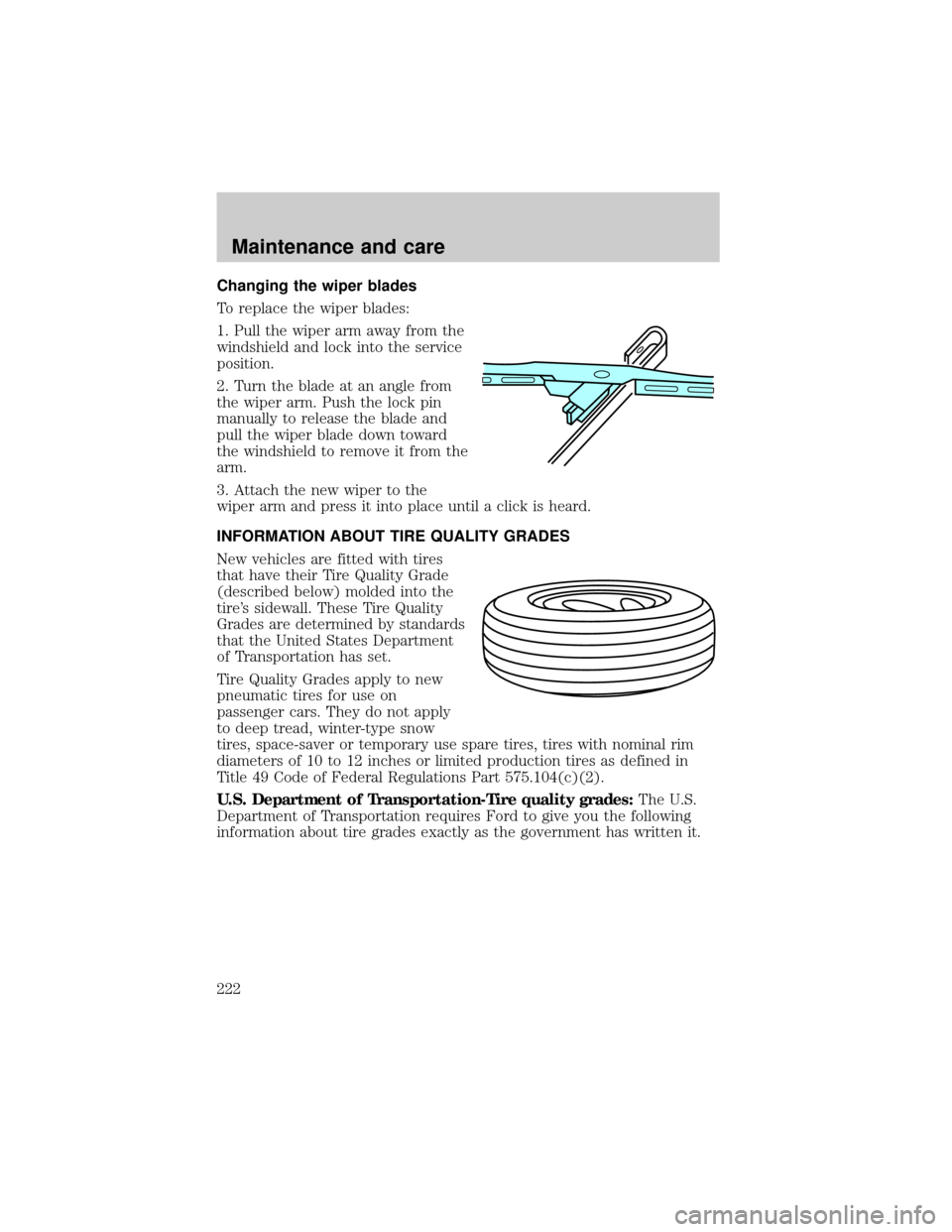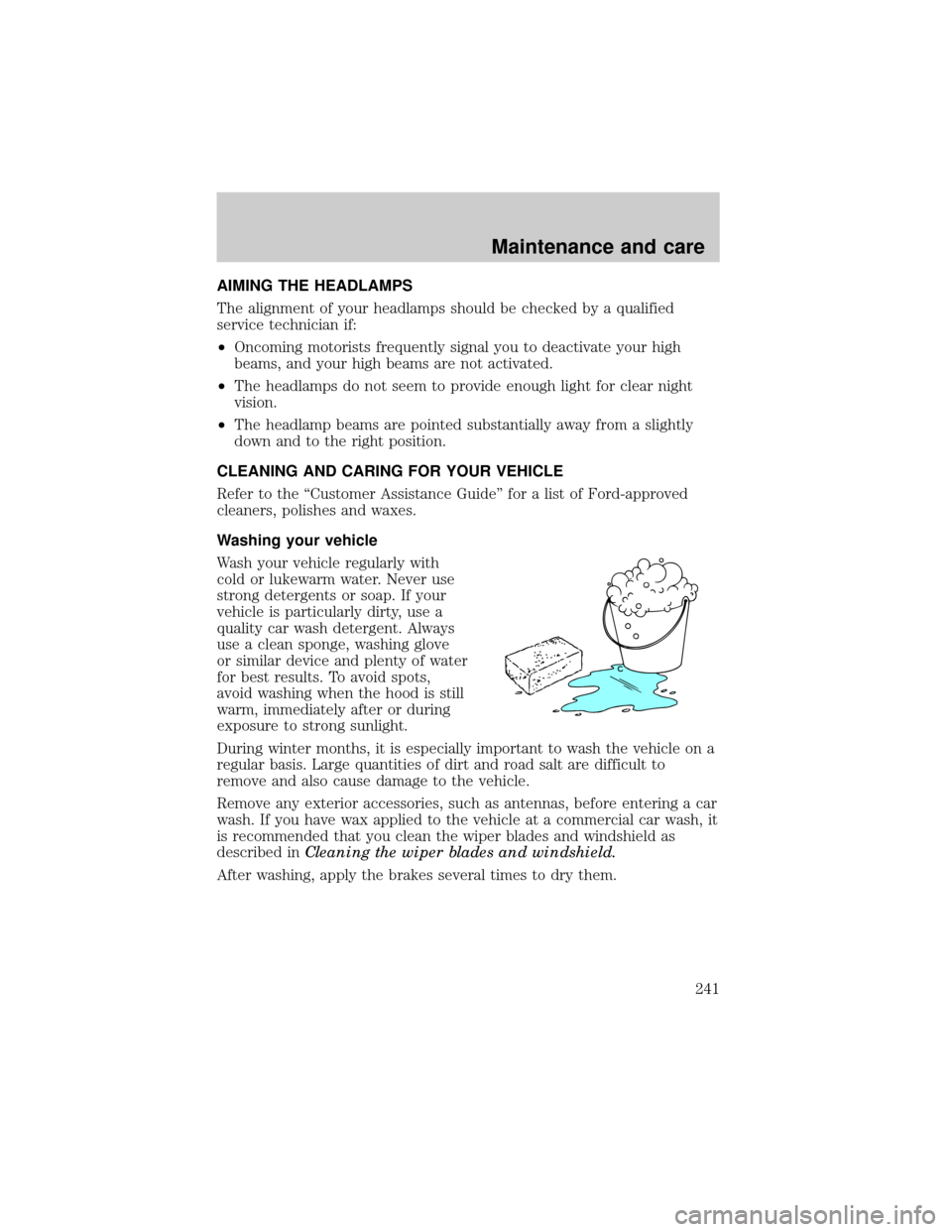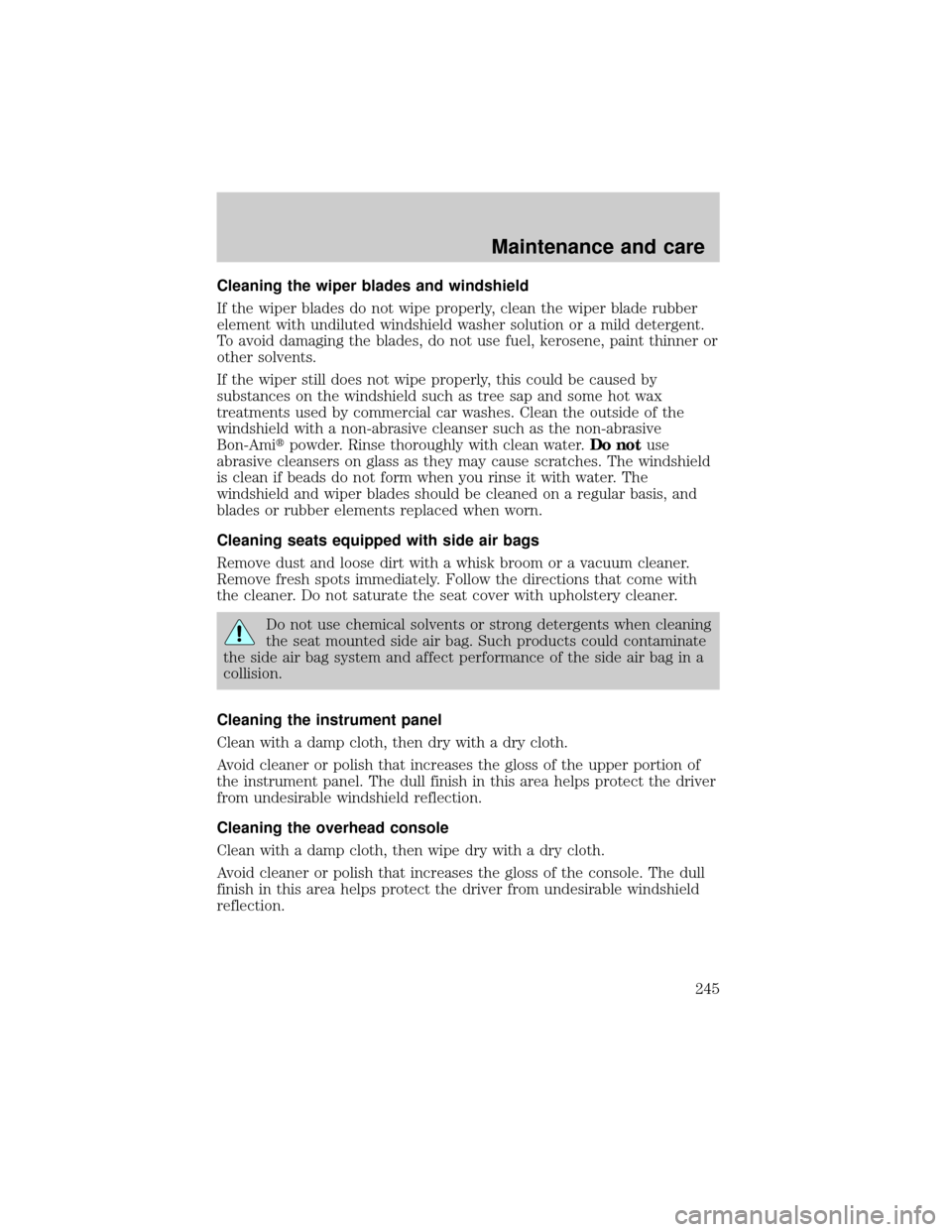1999 FORD EXPLORER wiper blades
[x] Cancel search: wiper bladesPage 221 of 264

1. Set your parking brake.
2. Put the gearshift in P (Park) (automatic transmission) or the neutral
position (manual transmission), turn off all accessories and start the
engine.
3. Let the engine idle for at least one minute.
4. The relearning process will automatically complete as you drive the
vehicle.
²The vehicle may need to be driven 16 km (10 miles) or more to
relearn the idle and fuel trim strategy.
²If you do not allow the engine to relearn its idle trim, the idle quality
of your vehicle may be adversely affected until the idle trim is
eventually relearned.
If the battery has been disconnected or a new battery has been installed,
the clock and the preset radio stations must be reset once the battery is
reconnected.
²Always dispose of automotive
batteries in a responsible manner.
Follow your local authorized
standards for disposal. Call your
local authorized recycling center
to find out more about recycling
automotive batteries.
WINDSHIELD WIPER BLADES
Check the wiper blades at least twice a year or when they seem less
effective. Substances such as tree sap and some hot wax treatments used
by commercial car washes reduce the effectiveness of wiper blades.
Checking the wiper blades
If the wiper blades do not wipe properly, clean both the windshield and
wiper blades using undiluted windshield wiper solution or a mild
detergent. Rinse thoroughly with clean water. To avoid damaging the
blades, do not use fuel, kerosene, paint thinner or other solvents.
LEAD
RETURN
RECYCLE
Maintenance and care
221
Page 222 of 264

Changing the wiper blades
To replace the wiper blades:
1. Pull the wiper arm away from the
windshield and lock into the service
position.
2. Turn the blade at an angle from
the wiper arm. Push the lock pin
manually to release the blade and
pull the wiper blade down toward
the windshield to remove it from the
arm.
3. Attach the new wiper to the
wiper arm and press it into place until a click is heard.
INFORMATION ABOUT TIRE QUALITY GRADES
New vehicles are fitted with tires
that have their Tire Quality Grade
(described below) molded into the
tire's sidewall. These Tire Quality
Grades are determined by standards
that the United States Department
of Transportation has set.
Tire Quality Grades apply to new
pneumatic tires for use on
passenger cars. They do not apply
to deep tread, winter-type snow
tires, space-saver or temporary use spare tires, tires with nominal rim
diameters of 10 to 12 inches or limited production tires as defined in
Title 49 Code of Federal Regulations Part 575.104(c)(2).
U.S. Department of Transportation-Tire quality grades:The U.S.
Department of Transportation requires Ford to give you the following
information about tire grades exactly as the government has written it.
Maintenance and care
222
Page 241 of 264

AIMING THE HEADLAMPS
The alignment of your headlamps should be checked by a qualified
service technician if:
²Oncoming motorists frequently signal you to deactivate your high
beams, and your high beams are not activated.
²The headlamps do not seem to provide enough light for clear night
vision.
²The headlamp beams are pointed substantially away from a slightly
down and to the right position.
CLEANING AND CARING FOR YOUR VEHICLE
Refer to the ªCustomer Assistance Guideº for a list of Ford-approved
cleaners, polishes and waxes.
Washing your vehicle
Wash your vehicle regularly with
cold or lukewarm water. Never use
strong detergents or soap. If your
vehicle is particularly dirty, use a
quality car wash detergent. Always
use a clean sponge, washing glove
or similar device and plenty of water
for best results. To avoid spots,
avoid washing when the hood is still
warm, immediately after or during
exposure to strong sunlight.
During winter months, it is especially important to wash the vehicle on a
regular basis. Large quantities of dirt and road salt are difficult to
remove and also cause damage to the vehicle.
Remove any exterior accessories, such as antennas, before entering a car
wash. If you have wax applied to the vehicle at a commercial car wash, it
is recommended that you clean the wiper blades and windshield as
described inCleaning the wiper blades and windshield.
After washing, apply the brakes several times to dry them.
Maintenance and care
241
Page 242 of 264

Waxing your vehicle
Wax when water stops beading on the surface. This could be every three
or four months, depending on operating conditions.
Use only carnauba or synthetic-based waxes. Use cleaning fluid or
alcohol with a clean cloth to remove any bugs and tar before waxing
vehicle. Use tar remover to remove any tar spots.
Avoid getting wax on the windshield. If you have wax applied at a
commercial car wash, it is recommended that you clean the wiper blades
and windshield as described inCleaning the wiper blades and
windshield.
Repairing paint chips
Minor scratches or paint damage from road debris may be repaired with
touch-up paint, repair foil or aerosol paint spray from the Ford accessory
line. Observe the application instructions on the products.
Remove particles such as bird droppings, tree sap, insect remains, tar
spots, road salt and industrial fallout immediately.
Cleaning the engine
Engines are more efficient when they are clean because grease and dirt
buildup keep the engine warmer than normal. When washing:
²Take care when using a power washer to clean the engine. The high
pressure fluid could penetrate the sealed parts and cause damage.
²Do not spray with cold water to avoid cracking the engine block or
other engine components.
²Cover the highlighted areas to prevent water damage when cleaning
the engine.
Maintenance and care
242
Page 245 of 264

Cleaning the wiper blades and windshield
If the wiper blades do not wipe properly, clean the wiper blade rubber
element with undiluted windshield washer solution or a mild detergent.
To avoid damaging the blades, do not use fuel, kerosene, paint thinner or
other solvents.
If the wiper still does not wipe properly, this could be caused by
substances on the windshield such as tree sap and some hot wax
treatments used by commercial car washes. Clean the outside of the
windshield with a non-abrasive cleanser such as the non-abrasive
Bon-Amitpowder. Rinse thoroughly with clean water.Do notuse
abrasive cleansers on glass as they may cause scratches. The windshield
is clean if beads do not form when you rinse it with water. The
windshield and wiper blades should be cleaned on a regular basis, and
blades or rubber elements replaced when worn.
Cleaning seats equipped with side air bags
Remove dust and loose dirt with a whisk broom or a vacuum cleaner.
Remove fresh spots immediately. Follow the directions that come with
the cleaner. Do not saturate the seat cover with upholstery cleaner.
Do not use chemical solvents or strong detergents when cleaning
the seat mounted side air bag. Such products could contaminate
the side air bag system and affect performance of the side air bag in a
collision.
Cleaning the instrument panel
Clean with a damp cloth, then dry with a dry cloth.
Avoid cleaner or polish that increases the gloss of the upper portion of
the instrument panel. The dull finish in this area helps protect the driver
from undesirable windshield reflection.
Cleaning the overhead console
Clean with a damp cloth, then wipe dry with a dry cloth.
Avoid cleaner or polish that increases the gloss of the console. The dull
finish in this area helps protect the driver from undesirable windshield
reflection.
Maintenance and care
245
Page 257 of 264

Air bag supplemental restraint
system ........................................126
and child safety seats ............128
description .......................127,130
disposal ....................................133
indicator light ..................130,132
passenger air bag ............128,131
Air conditioning
automatic temperature
control system .23,24,25,26,27,28
rear seat controls .....................29
Air suspension
description ..............................148
warning light .............................10
All Wheel Drive (AWD),
driving off road .........................162
Armrests ....................................102
Automatic transmission
driving an automatic
overdrive .....150,151,152,153,154
Axle
refill capacities ........................247
Battery
voltage gauge ............................14
Brakes ........................................145
anti-lock ............................145,146
anti-lock brake system (ABS)
warning light ...........................146
fluid, checking and adding ....208
shift interlock ..........................149
Break-in period ..........................2,3
Cargo area shade ......................104
Cargo cover ...............................104
CD player .....................75,77,78,79
Child safety seats
attaching with tether straps ..138
in rear seat ..............................136
tether anchorage hardware ...138
Cleaning your vehicle ...............241
engine compartment ..............242
exterior .............................242,244
exterior lamps .........................244interior ..............................245,246
plastic parts ............................244
washing ....................................241
waxing .....................................242
wheels ......................................244
windows ..................................246
wiper blades ............................245
woodtone trim ........................246
Clutch
fluid ..........................................209
operation while driving ...154,155
recommended shift speeds ....156
Compass, electronic ....................90
calibration .................................92
set zone adjustment .................91
Console ...............................101,102
overhead ...............................87,88
rear ..........................................102
Controls
power seat ...............................117
Coolant ...............................212,213
checking and adding ..............211
refill capacities ........................213
Defrost
rear window ..............................30
Driveline universal joint and
slip yoke ....................................219
Driving under special
conditions ...........................161,164
sand ..................................160,163
snow and ice ......160,162,163,164
through water ..................160,163
Emission control system ..........234
Engine
check engine/service engine
soon light ....................................6
coolant .....................................210
idle speed control ...................219
service points ............203,204,205
starting after a collision .........178
Engine block heater .................143
Index
257
Page 260 of 264

Transmission ......................149,215
automatic operation ...............149
fluid, checking and adding
(automatic) ......................215,216
fluid, checking and adding
(manual) .................................217
manual operation ....................154
Trip odometer .............................13
Universal transmitter (see
garage door opener) ....92,93,94,95
Vehicle dimensions ...................252
Vehicle Identification Number
(VIN) ..........................................255Vehicle loading ..........................165
Ventilating your vehicle ...........144
Warning chimes .............................6
Washer fluid ..............................210
reservoir ..................................210
Water, Driving through .............167
Windows .................................98,99
rear wiper/washer .....................86
Windshield washer fluid and
wipers
checking and cleaning ............221
operation ...................................85
replacing wiper blades ...........222
Index
260